COCAINE
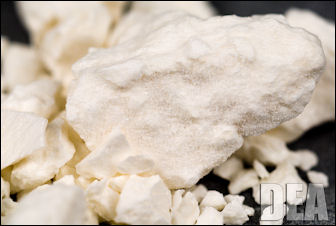
cocaine Cocaine is a powerfully addictive stimulant drug made from the leaves of the coca plant native to South America. Some regard it as the most pleasurable of all recreational drugs. In some experiments, laboratory animals able to self-administer it end up taking the drug to exclusion of almost everything else: food, drink and sex. [Sources: National Institute on Drug Abuse, National Institutes of Health, U.S. Department of Health and Human Services, April 2021; Peter White, National Geographic, January 1989]
For thousands of years, people in South America have chewed and ingested coca leaves (Erythroxylon coca), the source of cocaine, for their stimulant effects.The purified chemical, cocaine hydrochloride, was isolated from the leaves in 1860. In the early 1900s, purified cocaine was the main active ingredient in many tonics and elixirs developed to treat a wide variety of illnesses and famously was an ingredient in the early forms of Coca-Cola. Before the widespread use of synthetic local anesthetic, surgeons used cocaine to block pain. Today, cocaine is a Schedule II drug, which means that it is abused but can be administered by a doctor for legitimate medical uses, such as local anesthesia for some eye, ear, and throat surgeries.
Although health care providers can use it for valid medical purposes, such as local anesthesia for some surgeries, recreational cocaine use is illegal. As a street drug, cocaine looks like a fine, white, crystal powder. Dealers often “cut” (dilute) it with non-psychoactive substances such as cornstarch, talcum powder, flour, or baking soda to increase their profits. They may also adulterate cocaine with other drugs like procaine (a chemically related local anesthetic) the stimulant amphetamine, or synthetic opioids, including fentanyl. Adding synthetic opioids to cocaine is especially risky when people using cocaine don’t realize it contains this dangerous additive. Increasing numbers of overdose deaths among cocaine users might be related to this tampered cocaine. The mixture of cocaine and heroin is called a speedball. This deadly combination killed the comedian John Belushi and the actor River Phoenix.
Cocaine sells for around $75 to $200 a gram. In some places near where it is produced it is relatively cheap. In other places from the source, or with harsh penalties for trafficking it, such as Bali, the price can be quite high.
See Separate Articles:: HISTORY OF COCA AND COCAINE factsanddetails.com ; CULTIVATION OF COCA (THE SOURCE OF COCAINE) factsanddetails.com ; COCAINE PRODUCTION: JUNGLE LABS, WORKERS AND COCA PASTE factsanddetails.com ; GLOBAL COCAINE TRADE factsanddetails.com
Websites and Resources: U.S. Drug Enforcement Administration (DEA) justice.gov/dea/concern ; Vaults of Erowid erowid.org ; United Nations Office of Drugs and Crime (UNODC) unodc.org ; Wikipedia article on illegal drug trade Wikipedia ; Frank’s A-to-Z on Drugs talktofrank.com ; Streetdrugs.org streetdrugs.org ; Illegal Drugs, country by country listing, CIA cia.gov/library/publications/the-world-factbook
Books: “Illegal Drugs, Economy and Society in the Andes” by Francisco Thoumi (2003, Johns Hopkins University Press) is fascinating study of the Andean drug industry by an independent researcher with a Ph.D, in economic from the University of Minnesota. “Buzzed” by Cynthia Kuhn Ph.D. Scott Swartzwelder, Ph.D., Wilkie Wilson Ph.D. of the Duke University Medical Center (Norton, 2003); “Consuming Habits: Drugs in Anthropology and History” by Goodman, Sharratt and Lovejoy; “Drug War Heresies: Learning from Other Vices, Times and Places” by Robert MacCoun and Peter Reuter (Cambridge University Press).
Cocaine Use
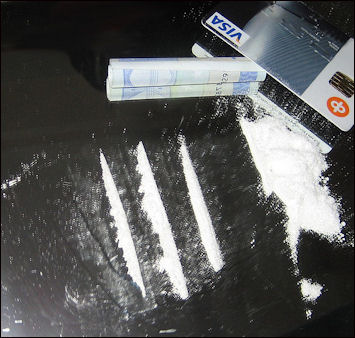
cocaine lines People abuse two chemical forms of cocaine: the water-soluble hydrochloride salt and the water-insoluble cocaine base (or freebase). Users inject or snort the hydrochloride salt, which is a powder. The base form (crack is smoked).
Most users snort (inhale) cocaine powder into their nose. According one study a large percentage of the $20 bills in circulation in the 1980s and 1990s had traces of cocaine on them. Some people rub cocaine into their gums. Others dissolve the powder and inject it into the bloodstream. Some people inject a speedball combination of cocaine and heroin. Another popular method of use is to smoke cocaine that has been processed to make a rock crystal (crack or "freebase cocaine", See Below).
When people snort the drug (intranasal use), they inhale cocaine powder through the nostrils, where it is absorbed into the bloodstream through the nasal tissues. Dissolving cocaine in water and injecting it (intravenous use) releases the drug directly into the bloodstream and heightens the intensity of its effects. Cocaine use ranges from occasional to repeated or compulsive use, with a variety of patterns between these extremes. Any route of administration can potentially lead to absorption of toxic amounts of cocaine, causing heart attacks, strokes, or seizures — all of which can result in sudden death. [Source: National Institute on Drug Abuse, National Institutes of Health, U.S. Department of Health and Human Services, May 2016]
After cocaine users snort, smoke or inject the drug they describe a "rush" that one addict told Newsweek feels "out of control" as if "in a dragster" or "being dangled 10 feet off the ground by a giant hand." The rush is followed by a high, euphoria and surge of energy. MRIs shows that at this stage the cocaine is very active in pleasure centers of the brain such as the sublenticular extended amygdala and nucleus accumbens.
Chewing leaves from the coca plant produces buzz-producing alkaloids that are absorbed only in minute amounts during digestion. Snorting cocaine shoots super concentrated forms of the alkaloids directly into the bloodstream. Injecting it gets large doses into the bloodstream and the brain even more quickly. People who use cocaine often take it in binges — taking the drug repeatedly within a short time, at increasingly higher doses — to maintain their high.
Crack and Freebase Cocaine
Crack is a concentrated type of cocaine that comes in the form of “rocks” or “stones” and is usually smoked in a pipe. The high that users experience is short, intense and very pleasurable. The drug is highly addictive and users intensely want another hit almost immediately after they had the last one. Crack is the water-insoluble base (freebase) form of cocaine. Essentially powdered cocaine that has been reverse-engineered back to a chemical base state, thereby rendering it smokeable, it is created by processing the drug with ammonia or sodium bicarbonate (baking soda) and water, then heating it to remove the hydrochloride. When people smoke cocaine (inhalation), they inhale its vapor or smoke into the lungs, where absorption into the bloodstream is almost as rapid as by injection. This fast euphoric effect is one of the reasons that crack became enormously popular in the mid-1980s. One user told the told the Independent, “It’s like a religious rapture when you first take it. But after the experience diminishes, you seem to spend an eternity trying to connect with it again.”
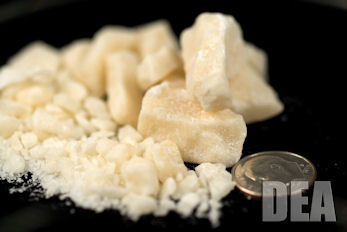
crack cocaine During the process of creating cocaine base, the cocaine alkaloid is "freed" from the salt that was added during the production of cocaine hydrochloride. That is why it is called freebase. The resulting substance is chemically similar to coca paste, but without many of the adulterants found in paste. When cocaine is smoked as coca paste or crack, the intensity of the sensation is said to be indescribably intense. The absorption of a drug through the air sacs of the lungs, which have the surface area the size of a tennis court, is rapid. Crack takes about 19 seconds to reach the brain. Maximum psychotropic effect is attained approximately two minutes after inhalation. The physiological and psychotropic effects of crack are sustained for approximately 30 minutes after the peak effects are attained. [Source: CIA]
Since the 1970s, cocaine hydrochloride has been converted into one of two forms of smokeable cocaine base, freebase cocaine or crack cocaine. Both are referred to as "cocaine base," because both are in the chemical base state and can therefore be smoked. Freebase cocaine was used by a small community of affluent cocaine users during the 1970s and early 1980s. Although crack may have been used during the same timeframe, it did not gain notoriety until the early 1980s.
Crack generally sells for more than twice what cocaine sells for but is sold in smaller more affordable quantities. Hits that sell for about $25 will give users an intense rush. Crack is a rock-liike crystal. When it is heated it produces vapors that are inhaled into the lungs. Crackrefers to the crackling sound of the crystal as it's heated. Some people smoke crack by sprinkling it on marijuana or tobacco, and smoke it like a cigarette.
How Cocaine Works
Dopamine is a neurotransmitter and a natural chemical messenger associated with pleasure and other things. Unlike opiates which stimulate the dopamine-producing receptors, cocaine works by blocking the receptor molecules of neurons used to reabsorb dopamine and inhibiting the chemicals and enzymes that try to stem its flow. This means that the dopamine remains in the bloodstream to bring pleasure.
Cocaine increases levels of dopamine in the brain circuits related to the control of movement and reward. Normally, dopamine recycles back into the cell that released it, shutting off the signal between nerve cells. However, cocaine prevents dopamine from being recycled, causing large amounts to build up in the space between two nerve cells, stopping their normal communication. This flood of dopamine in the brain’s reward circuit strongly reinforces drug-taking behaviors. With continued drug use, the reward circuit may adapt, becoming less sensitive to the drug. As a result, people take stronger and more frequent doses in an attempt to feel the same high, and to obtain relief from withdrawal. [Source: National Institute on Drug Abuse, National Institutes of Health, U.S. Department of Health and Human Services, April 2021]
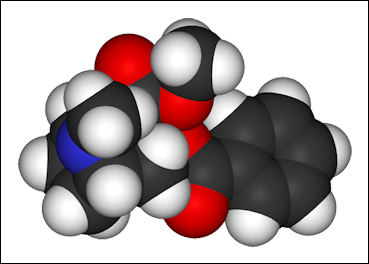
Cocaine molecule
One dose of cocaine releases two to ten times the amount of dopamine produced by a natural stimulus such as favorite meal or song.
Cocaine and amphetamines cause an abundance of dopamine to stay in the cleft between nerve cells, stimulating them. The brain’s mesolimbic dopamine system, its reward pathway, is stimulated by all types of reinforcing stimuli, such as food, sex, and many drugs of abuse, including cocaine. This pathway originates in a region of the midbrain called the ventral tegmental area and extends to the nucleus accumbens, one of the brain’s key reward areas. Besides reward, this circuit also regulates emotions and motivation.
In the normal communication process, dopamine is released by a neuron into the synapse (the small gap between two neurons), where it binds to specialized proteins called dopamine receptors on the neighboring neuron. By this process, dopamine acts as a chemical messenger, carrying a signal from neuron to neuron. Another specialized protein called a transporter removes dopamine from the synapse to be recycled for further use. Drugs of abuse can interfere with this normal communication process. For example, cocaine acts by binding to the dopamine transporter, blocking the removal of dopamine from the synapse. Dopamine then accumulates in the synapse to produce an amplified signal to the receiving neurons. This is what causes the euphoria commonly experienced immediately after taking the drug. [Source: National Institute on Drug Abuse, National Institutes of Health, U.S. Department of Health and Human Services, May 2016]
Cocaine and the Brain
In the normal neural communication process, dopamine is released by a neuron into the synapse, where it can bind to dopamine receptors on neighboring neurons. Normally, dopamine is then recycled back into the transmitting neuron by a specialized protein called the dopamine transporter. If cocaine is present, it attaches to the dopamine transporter and blocks the normal recycling process, resulting in a buildup of dopamine in the synapse, which contributes to the pleasurable effects of cocaine. [Source: National Institute on Drug Abuse, National Institutes of Health, U.S. Department of Health and Human Services, May 2016]
Use of cocaine, like other drugs of abuse, induces long-term changes in the brain. Animal studies show that cocaine exposure can cause significant neuroadaptations in neurons that release the excitatory neurotransmitter glutamate. Animals chronically exposed to cocaine demonstrate profound changes in glutamate neurotransmission — including how much is released and the level of receptor proteins — in the reward pathway, particularly the nucleus accumbens. The glutamate system may be an opportune target for anti-addiction medication development, with the goal of reversing the cocaine-induced neuroadaptations that contribute to the drive to use the drug.
Although addiction researchers have focused on adaptations in the brain’s reward system, drugs also affect the brain pathways that respond to stress. Stress can contribute to cocaine relapse, and cocaine use disorders frequently co-occur with stress-related disorders. The stress circuits of the brain are distinct from the reward pathway, but research indicates that there are important ways that they overlap. The ventral tegmental area seems to act as a critical integration site in the brain that relays information about both stress and drug cues to other areas of the brain, including ones that drive cocaine seeking. Animals that have received cocaine repeatedly are more likely to seek the drug in response to stress, and the more of the drug they have taken, the more stress affects this behavior. Research suggests that cocaine elevates stress hormones, inducing neuroadaptations that further increase sensitivity to the drug and cues associated with it.
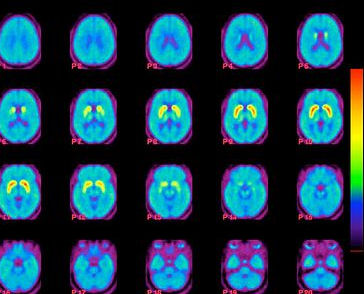
cocaine brain Brain scans of cocaine addicts show reduced activity in the frontal cortex, an area of the brain involved in behavior, decision-making and self control. Brain images of decreased glucose metabolism, which indicates reduced activity, in the orbitofrontal cortex (OFC) of a control subject and a cocaine-addicted subject appear to show that chronic cocaine exposure affects many other areas of the brain too. For example, animal research indicates that cocaine diminishes functioning in the orbitofrontal cortex (OFC), which appears to underlie the poor decision-making, inability to adapt to negative consequences of drug use, and lack of self-insight shown by people addicted to cocaine.A study using optogenetic technology, which uses light to activate specific, genetically-modified neurons, found that stimulating the OFC restores adaptive learning in animals. This intriguing result suggests that strengthening OFC activity may be a good therapeutic approach to improve insight and awareness of the consequences of drug use among people addicted to cocaine.
Effects of Cocaine
Short-term health effects of cocaine include: 1) extreme happiness and energy; 2) mental alertness; and 3) hypersensitivity to sight, sound, and touch.Cocaine’s effects appear almost immediately after a single dose and disappear within a few minutes to an hour. Small amounts of cocaine usually make the user feel euphoric, energetic, talkative and mentally alert. The drug can also temporarily decrease the need for food and sleep. Some people find that cocaine helps them perform simple physical and mental tasks more quickly, although others experience the opposite effect. Large amounts of cocaine can lead to bizarre, unpredictable, and violent behavior. [Source: National Institute on Drug Abuse, National Institutes of Health, U.S. Department of Health and Human Services, April 2021, May 2016]
How long the effects last and how intense they are depend on the method of use. Injecting or smoking cocaine produces a quicker and stronger but shorter-lasting high than snorting. The high from snorting cocaine may last 15 to 30 minutes. The high from smoking may last 5 to 10 minutes. Large amounts of cocaine may intensify the user’s high but can also lead to bizarre, erratic, and violent behavior. Some cocaine users report feelings of restlessness, irritability, anxiety, panic, and paranoia. Users may also experience tremors, vertigo, and muscle twitches. The cocaine high is often followed by intense depression. Long term crack users often are anxious, paranoid and have a tendency to fly into aggressive rages.
The route of cocaine administration determines the rate at which a drug is absorbed into the bloodstream, which in turn determines the intensity of the body's reaction to a drug. Absorption of a drug is affected by two factors: the amount of blood flowing to the site of consumption and the surface area over which the drug is absorbed. When cocaine is administered through nasal insufflation, it is absorbed through the relatively small nasal mucosa in the nasal cavity. It appears in the bloodstream three to five minutes after administration; maximum psychotropic effect is achieved in 20 minutes; and the effects are sustained for roughly one hour after peak effect. When cocaine is injected, it immediately reaches the bloodstream; reaches the brain within one minute; maximum psychotropic effect is reached in four minutes; and the effects linger for about 30 minutes. Injecting and insufflating are inefficient routes of administration when compared to smoking, the characteristics of which are described below. [Source: CIA]
Physical effects of cocaine can include:1) constricted blood vessels; 2) dilated pupilsnausea; 3) raised body temperature and blood pressure; 4) fast or irregular heartbeat; 5) tremors and muscle twitches; and 6) restlessness. Cocaine blocks nerve sensations, causing numbness and constricts blood vessels and thus is useful as local anesthesia and means of controlling bleeding. Each year surgeons in the United States perform tens of thousands of operations involving the nose using cocaine, which shuts down the mass of capillaries in the nose. Nurses used to sometimes swab a little bit on a wound needing stitches to stop the bleeding. [Source: Peter White, National Geographic, January 1989]
Some of the most frequent severe medical complications that can occur with cocaine use are cardiovascular effects, including disturbances in heart rhythm and heart attacks; neurological effects, including headaches, seizures, strokes, and coma; and gastrointestinal complications, including abdominal pain and nausea. Other symptoms of cocaine overdose include difficulty breathing, high blood pressure, high body temperature, hallucinations, and extreme agitation or anxiety.
Cocaine Users
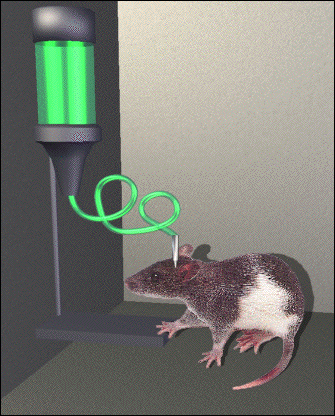
In the United States, the first wave of cocaine use peaked in the late 1970s and early 1980s and declined after that. Since the end of crack epidemic of the late 1980s cocaine use dropped significantly. Between 1985 and 1999, cocaine use in the U.S. fell by 70 percent, with cocaine prices in Europe and North America falling to half what they were in the 1980s. Worldwide, abuse of the drug rose through the 1990s and 2000s in many places, including Europe. In the early 2000s it was estimated that cocaine was used by 13.4 million people worldwide, with around 3.5 million users in Europe. According to the United Nations annual report on drugs, issued in June 2009, global use of cocaine fell in 2008. In 2009, the Economist magazine reckoned that the production of cocaine was roughly the same as it was a decade earlier.
According to the UNODC: In 2019, roughly 20 million people worldwide (range: 17–25 million), or 0.4 percent of the adult population aged 15–64 (range: 0.3 percent–0.5 percent), had used cocaine in the past year. A high prevalence of cocaine use is estimated in Oceania (mainly for the subregion Australia and New Zealand, where it is 2.7 percent), North America (2.1 percent), Western and Central Europe (1.4 percent) and South and Central America (nearly 1.0. percent). The estimated extent of cocaine use in other subregions is far below the global average, although the availability of data is limited. [Source: United Nations Office on Drugs and Crime (UNODC), World Drug Report 2021]
Between 2010 and 2019, the estimated prevalence of pastyear cocaine use remained fairly stable, at about 0.4 percent, but population growth led to an increase of 22 percent in the number of people who had used cocaine in the past year. These estimates and global trends should be interpreted with caution, however, given the intrinsic limitations of general population surveys71 and since only a limited number of countries provide new estimates every year. Cocaine use varies greatly across subregions and regions and the error margins are too wide to allow conclusions to be drawn about a statistically significant increase in cocaine use in the past decade.
In the U.S., according to the 2020 National Survey on Drug Use and Health and the 2021 Monitoring the Future Survey about 1.9 percent of people aged 12 or older(about 5.2 million people) reported using cocaine in the past 12 months in 2020. In 2021, an estimated 0.2 percent of 8th graders, 0.6 percent of 10th graders, and 1.2 percent of 12th graders reported using cocaine in the past 12 months.In 2019, 5.5 million people, or 2.0 percent of the population aged 12 and older, had used cocaine in the past year. As a long-term trend, past-year use of cocaine reached a low in 2011 but increased thereafter and stabilized at a high level from 2016. Cocaine use in the United States is highest among young people (aged 18–25), with a past-year prevalence of 5.3 percent in 2019. The prevalence of use of “crack” cocaine is much lower, with 778,000 people, or 0.3 percent of the population aged 12 and older, reporting use of the substance in the past year. Among adults aged 18 and older, comparatively higher “crack” cocaine use is reported among those aged 26 and older. Generally, cocaine use is more common among socially integrated cocaine users, whereas cocaine injecting and use of “crack” cocaine is more common among socially marginalized groups of users.88, 89 Among the 5.5 million people in the Unites States who had used cocaine in the past year in 2019, nearly 2 million (0.7 percent of the population aged 12 and older) were estimated to have used the drug on an average of 5.5. days in the past month. Among past-month users, 8.8 percent (175,000 people) were estimated to be daily or neardaily users of cocaine. [Source: United Nations Office on Drugs and Crime (UNODC), World Drug Report 2021]
Types of Cocaine Users
The upsurge in cocaine use from the mid-1970s to the mid-1980s was primarily the result of increased consumption of cocaine hydrochloride administered intranasally by middle-class and upper-class cocaine users. Few cocaine users were injecting cocaine during this period, and even fewer were making the effort to convert it to cocaine base. The emergence of crack cocaine fundamentally altered these demographics. [Source: CIA]
In the 1980s the price of coca dropped so low that highly addictive coca paste becomes affordable to the local populations in South America. In Peru, disheveled and hollow-faced paste smokers, called “ mosacs” , robbed old ladies and shoplifted like United States crack addicts to pay for their habit. The problem was so bad that some parents checked their addicted children into hospitals to have part of their brain removed in an attempt to stop their addiction. [Source: Peter White, National Geographic, January 1989]
According to the UNODC: Some of the national data from different subregions, presented in the present chapter, and studies, conducted mainly in European countries, suggest that people who use cocaine products (cocaine hydrochloride, cocaine base, “crack” cocaine and other products such as base paste, “oxi”, “basuco” or “merla” (in South America)) may be grouped into different categories according to different dimensions. One such dimension, which is often used, is the extent of social integration, although it may project only a limited understanding of a very diverse population. The spectrum of people using cocaine products has thus been portrayed as encompassing those who are socially integrated and those who are socially marginalized. Such a dichotomy has, however, been increasingly challenged by the intersection of the two groups with regard to some characteristics, thereby highlighting the need to consider a nuanced spectrum of patterns of cocaine use and groups of users instead. [Source: United Nations Office on Drugs and Crime (UNODC), World Drug Report 2021]
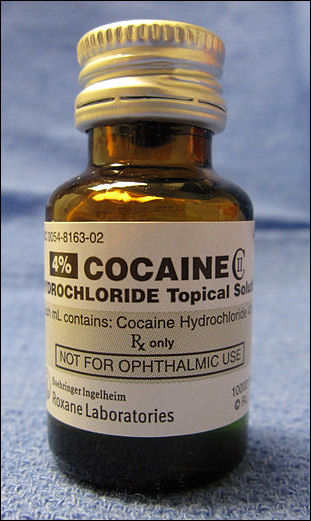
Cocaine hydrochloride for medicinal use
At one end of the spectrum are socially integrated cocaine users who are considered as those with stable living conditions and regular employment who use cocaine alone or in combination with other drugs. Use of the drug in nightlife and other recreational settings is a common feature, although not the only pattern of use, observed among socially integrated cocaine users.g, a A subset of recreational cocaine users also develops a more regular or harmful pattern of use that extends beyond party settings, and may lead to cocaine use disorders.
At the other end are socially marginalized groups of cocaine users who are characterized as those with socioeconomic and health problems, including people who are homeless. They may use cocaine products and other drugs within “street drug scenes”; they are often former or current heroin or opioid users and many inject cocaine or “crack” cocaine. Frequency of cocaine use, patterns of consumption and health consequences vary between the different groups of users, but polydrug use is a predominant pattern among people who use cocaine. In general, socially integrated cocaine users have a lower frequency of use than socially marginalized cocaine users. One study reported that one third of the socially integrated group reported regular use of cocaine (more than two times per week), compared with 81 percent in the marginalized group.
Using Cocaine and Other Drugs
According to the UNODC: A common feature of drug use, polydrug use is also a common pattern of use among people who use cocaine products; cocaine is frequently combined with, rather than used as a replacement for, other drugs. The highest intensity of polydrug use, however, is found among socially marginalized groups. Such a pattern of polydrug use among cocaine users may include the concomitant and sequential use of alcohol, cannabis, “ecstasy”, benzodiazepine and heroin (the most commonly reported substances). The use of cocaine among heroin users, including among those in opioid agonist treatment, is seen as a means of potentiating the desired effect of the other drugs used, as well as a means of reducing their undesired effects (such as withdrawal). [Source: United Nations Office on Drugs and Crime (UNODC), World Drug Report 2021]
The literature has also reported a strong relationship between injecting cocaine and injecting heroin. Indeed, heroin (by injection) has been reported as the predominant substance used by socially marginalized cocaine (and “crack” cocaine) users. a Apart from polydrug use, the use of cocaine by injection has also been reported recently in new HIV outbreaks among PWID in Europe and North America. In Scotland, for example, recent epidemiological studies have demonstrated that HIV prevalence among PWID in Glasgow city centre increased from 1.1 percent in the period 2011–2012 to 10.8 percent in the period 2017– 2018. The increase in HIV prevalence was associated with homelessness, incarceration, injecting cocaine and injecting in outdoor or public places. Use of cocaine has also been associated with psychiatric comorbidities, especially anti-social personality disorder and symptoms such as anxiety, depression, paranoia and psychosis.
Polydrug use, in particular heroin use, among cocaine users is also associated with an increased risk of overdose and mortality. A longitudinal study among cocaine users recruited over the period 1989–2013 in Italy found that, during the 38 years of the study’s follow-up, the excess mortalityu for all causes among the cohort was 6.24. It was higher among women (15.03) than among men (6.24) and it was higher among those using heroin and cocaine (9.06) than among those using only cocaine (5.21). Of the deaths of those who had been using cocaine only, most were the result of road accidents and suicide; the deaths of those who had been using cocaine and heroin were attributed to opioid overdose and cardiovascular diseases.k, A retrospective cohort study of heroin and cocaine users in Spain (over the period 1997–2007) reported that the crude mortality rate from overdoses and injuries was very high, especially among those aged 40–59. The crude mortality rate among the cohort was 191 deaths per 100,000 person years as a result of overdose and 88 deaths per 100,000 person years as a result of injuries among people who used only cocaine. Among those who reported the use of heroin and cocaine, the crude mortality rate was much higher (595 deaths per 100,000 person years as a result of overdose and 217 deaths per 100,000 person years as a result of injuries).
Cocaine Overdoses and Deaths
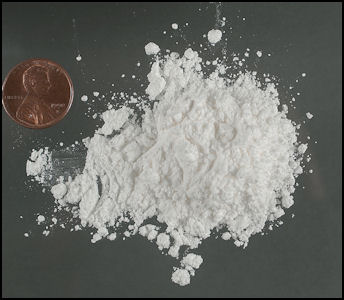
cocaine
In 2020, approximately 19,447 people in the U.S. died from an overdose involving cocaine according to CDC WONDER Database. In a study by a team led by Prof. David Nutt of Britain’s Bristol University published in the British medical journal Lancet heroin and cocaine ranked as the most dangerous drugs followed by barbiturates and street methadone. In the old days, acute deaths caused solely by cocaine use were very rare. In the Netherlands in the 1980s and 90s there were about 100 deaths a year from heroin but only one or two from cocaine. Now there are many more cocaine-caused deaths.
A cocaine overdose occurs when a person uses enough of a drug to produce serious adverse effects, life-threatening symptoms, or death. An overdose can be intentional or unintentional. Cocaine-related deaths are often a result of cardiac arrest or seizures. In rare instances, sudden death can occur on the first use of cocaine or unexpectedly thereafter.
Cocaine-related deaths often happen when the person goes into cardiac arrest, meaning the heart stops, and then breathing stops. The wife of one cocaine victim said that her 38-year-old husband suffered a heart attack and was taken to the intensive care unit.. He “never woke up” and “there was too much time without oxygen, causing irreversible brain damage,” she wrote on Facebook. The local coroner said that after an investigation he had determined the cause of death was “acute cocaine intoxication” and the manner was accidental. [Source: Today, January 7, 2021]
Many cocaine users also use alcohol, and this combination can be particularly dangerous. The two substances react to produce cocaethylene, which may potentiate the toxic effects of cocaine and alcohol on the heart. The combination of cocaine and heroin is also very dangerous. Users combine these drugs because the stimulating effects of cocaine are offset by the sedating effects of heroin; however, this can lead to taking a high dose of heroin without initially realizing it. Because cocaine's effects wear off sooner, this can lead to a heroin overdose, in which the user's respiration dangerously slows down or stops, possibly fatally. [Source: National Institute on Drug Abuse, National Institutes of Health, U.S. Department of Health and Human Services, April 2021, May 2016]
According to the UNODC: In addition to overdose deaths attributed to opioid use in the United States, those attributed to cocaine use have also been increasing, in particular since 2014: over the period 2010–2019, the number of overdose deaths attributed to cocaine use increased nearly fourfold. However, this increase is attributed to a large extent to deaths that also involved an opioid, most notably synthetic opioids (fentanyls). In 2019, of the total 15,883 overdose deaths attributed to cocaine, 75 percent involved an opioid, mostly fentanyls. While it is not known if the deaths were the result of the concomitant, sequential or inadvertent use of the two drugs, there have been reports of cocaine being either mixed inadvertently with fentanyls or adulterated with fentanyls in the United States. [Source: United Nations Office on Drugs and Crime (UNODC), World Drug Report 2021]
There is no specific medication that can reverse a cocaine overdose. Management involves supportive care and depends on the symptoms present. For instance, because cocaine overdose often leads to a heart attack, stroke, or seizure, first responders and emergency room doctors try to treat the overdose by treating these conditions, with the intent of: 1) restoring blood flow to the heart (heart attack); 2) restoring oxygen-rich blood supply to the affected part of the brain (stroke); 3) stopping the seizure.
Long-Term Effects of Cocaine on the Brain
With repeated exposure to cocaine, the brain starts to adapt so that the reward pathway becomes less sensitive to natural reinforcers. At the same time, circuits involved in stress become increasingly sensitive, leading to increased displeasure and negative moods when not taking the drug, which are signs of withdrawal. These combined effects make the user more likely to focus on seeking the drug instead of relationships, food, or other natural rewards. With regular use, tolerance may develop so that higher doses, more frequent use of cocaine, or both are needed to produce the same level of pleasure and relief from withdrawal experienced initially. At the same time, users can also develop sensitization, in which less cocaine is needed to produce anxiety, convulsions, or other toxic effects. Tolerance to cocaine reward and sensitization to cocaine toxicity can increase the risk of overdose in a regular user. [Source: National Institute on Drug Abuse, National Institutes of Health, U.S. Department of Health and Human Services, May 2016]
Chronic cocaine use is said to harm neurons in the brain associated with pleasure. Some theories suggest the body uses up all the body's supply of dopamine so that pleasure is impossible.. This may explain why cocaine addicts have a high rate of depression. Generally, studies suggest that a wide range of cognitive functions are impaired with long-term cocaine use — such as sustaining attention, impulse inhibition, memory, making decisions involving rewards or punishments, and performing motor tasks.
Users take cocaine in binges, in which cocaine is used repeatedly and at increasingly higher doses. This can lead to increased irritability, restlessness, panic attacks, paranoia, and even a full-blown psychosis, in which the individual loses touch with reality and experiences auditory hallucinations. With increasing doses or higher frequency of use, the risk of adverse psychological or physiological effects increases. Animal research suggests that binging on cocaine during adolescence enhances sensitivity to the rewarding effects of cocaine and MDMA (Ecstasy or Molly).Thus, binge use of cocaine during adolescence may further increase vulnerability to continued use of the drug among some people.
Long Term Health Effects of Cocaine
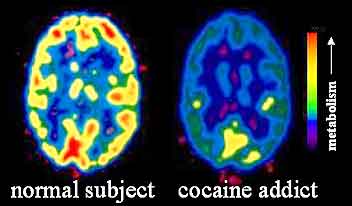
PET image of cocaine addictLong-term effects of cocaine use include increased risk for stroke and seizures and other neurological problems. There have been reports of intracerebral hemorrhage, or bleeding within the brain, and balloon-like bulges in the walls of cerebral blood vessels. Movement disorders, including Parkinson’s disease, may also occur after many years of cocaine use. An Italian study suggests that chronic use may cause DNA mutation. A Harvard study indicates that frequent cocaine use slowly causes blood vessels to become inflamed and clotting to begin, increasing the risk of a heart attack or stroke. Cocaine also causes the body to produce blood-thickening agents normally activated after an injury to halt blood loss.
Cocaine damages many other organs in the body. It reduces blood flow in the gastrointestinal tract, which can lead to tears and ulcerations. Many chronic cocaine users lose their appetite and experience significant weight loss and malnourishment. Cocaine has significant and well-recognized toxic effects on the heart and cardiovascular system.Chest pain that feels like a heart attack is common and sends many cocaine users to the emergency room. Cocaine use is linked with increased risk of stroke, as well as inflammation of the heart muscle, deterioration of the ability of the heart to contract, and aortic ruptures. [Source: National Institute on Drug Abuse, National Institutes of Health, U.S. Department of Health and Human Services, May 2016]
Some long-term health effects of cocaine depend on the method of use and include the following:1) Regularly snorting cocaine can lead to loss of sense of smell, nosebleeds, problems with swallowing, hoarseness, and an overall irritation of the nasal septum leading to a chronically inflamed, runny nose. 2) Smoking crack cocaine damages the lungs and can worsen asthma and can cause coughing, respiratory distress, and higher risk of infections like pneumonia; 3) Consuming by mouth can cause severe bowel decay from reduced blood flow. 4) People who inject cocaine have puncture marks called tracks, most commonly in their forearms, and they are at risk of contracting infectious diseases like HIV and hepatitis C or get skin or soft tissue infections, as well as scarring or collapsed veins.. They also may experience allergic reactions, either to the drug itself or to additives in cocaine, which in severe cases can result in death. Even people involved with non-needle cocaine use place themselves at a risk for HIV because cocaine impairs judgment, which can lead to risky sexual behavior with infected partners. [Source: National Institute on Drug Abuse, National Institutes of Health, U.S. Department of Health and Human Services, April 2021]
Studies have shown that cocaine use speeds up HIV infection. According to research, cocaine impairs immune cell function and promotes reproduction of the HIV virus. Research also suggests that people who use cocaine and are infected with HIV may be more susceptible to contracting other viruses, such as hepatitis C, a virus that affects the liver.
Cocaine and Crack Addiction
Among people aged 12 or older in 2020, 0.5 percent (or about 1.3 million people) had a cocaine use disorder in the past 12 months according to the 2020 National Survey on Drug Use and Health. Studies in the 2000s indicated that about 20 percent of cocaine users were dependent on the drug, compared to more than 80 percent for nicotine. The recovery rate for cocaine addicts is 90 percent, compared to 40 to 50 percent for heroin. Heroin, cocaine, amphetamines, alcohol and nicotine are regarded as the five drugs hardest to give up. Studies have found that women are more likely to become addicted to cocaine than men.
As with other drugs, repeated use of cocaine can cause long-term changes in the brain’s reward circuit and other brain systems, which may lead to addiction. The reward circuit eventually adapts to the extra dopamine caused by the drug, becoming steadily less sensitive to it. As a result, people take stronger and more frequent doses to feel the same high they did initially and to obtain relief from withdrawal. [Source: National Institute on Drug Abuse, National Institutes of Health, U.S. Department of Health and Human Services, April 2021]
Withdrawal symptoms include: 1) depression; 2) fatigue; 3) increased appetite; 3) unpleasant dreams and insomnia; slowed thinking. In contrast to heroin and other opiates, cocaine withdrawal is much less dramatic, characterized by sleep disturbances and depression rather than leg spasms and severe cramps and nausea like that experienced by heroin addict going cold turkey. Some researchers believe that no real withdrawal syndrome exists for cocaine, marijuana, amphetamines, and hallucinogens, since withdrawal symptoms appeared to be psychological rather than physical. [Source: PBS, WGBH, Frontline 1998]
Crack cocaine that people smoke is significantly more addictive than powdered cocaine that people snort. After trying crack a few times, users often have a difficult time giving it up but they don't become physically ill when withdrawing like heroin addicts do. When crack addicts under an MRI are shown a picture of people dealing and smoking crack the anterior cingulate, part of the brain associated with moods and leaning, lights up dramatically. Non addicts show no such brain activity.
Crack addicts are constantly desperate for money to purchase the drug and will do almost anything to get it — crime, prostitution, stealing from one’s parents . The Independent newspaper described one man who committed seven burglaries in one night and pissed away the earnings at a crack house between each one.
Former cocaine users are at high risk for relapse, even following long periods of abstinence. Research indicates that during periods of abstinence, the memory of the cocaine experience or exposure to cues associated with drug use can trigger strong cravings, which can lead to relapse. [Source: National Institute on Drug Abuse, National Institutes of Health, U.S. Department of Health and Human Services, May 2016]
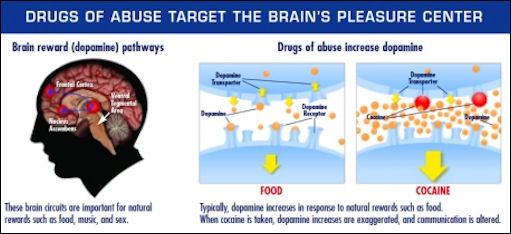
Treatments for Cocaine Addiction
In 2013, cocaine accounted for almost 6 percent of all admissions to drug abuse treatment programs. The majority of individuals (68 percent in 2013) who seek treatment for cocaine use smoke crack and are likely to be polydrug users, meaning they use more than one substance. [Source: National Institute on Drug Abuse, National Institutes of Health, U.S. Department of Health and Human Services, May 2016]
The main treatments for cocaine addiction are counseling, therapy and counseling. Behavioral therapy may be used to treat cocaine addiction. Examples include:1) cognitive-behavioral therapy; 2) contingency management or motivational incentives — providing rewards to patients who remain substance free; 3) therapeutic communities — drug-free residences in which people in recovery from substance use disorders help each other to understand and change their behaviors; 4) community based recovery groups, such as 12-step programs. While there are no FDA-approved medications for the treatment of cocaine use disorder, NIDA supports a robust medication development pipeline in this area. [Source: National Institute on Drug Abuse, National Institutes of Health, U.S. Department of Health and Human Services, April 2021]
At the Healing Visions Institute of Addiction Recovery in St. Kitts addicts are given a hallucinogen called ibogaine. Patients only take it once. The drug is made from the bark of the “Tabernanthe iboga”, a powerful hallucinogenic being found in the rain forests of Gabon and used in initiation rituals of the Bwiti people. It produces a powerful 36-hour trip filled with living dreams and jolting self- realization experiences.
Scientists have been able to develop an equivalent of methadone, naltrexone or buprenorphine for cocaine (See Heroin Addiction). This is because cocaine works by blocking the receptor of neurons used to reabsorb dopamine and it is difficult to develop a blocker for a blocker. Scientists at Yale have invented a drug neutralizes the cocaine molecule whenever it enters the bloodstream.
Vigabatrin, a drug that stimulates the production of Gamma-aminobutyric acid, or GABA, a neurotransmitter that has an inhibitory effect on neurons, is used to treat cocaine addicts. In one study, 30 percent of the cocaine addicts that took it were able to stay off the drug, compared to just 5 percent in a control group. What was perhaps most remarkable about the treatment was that it was effective with people written off as hopeless addicts.
Researchers are trying to develop a vaccine that would prevent drug users from getting high. An experimental cocaine vaccine has been made of cocaine molecules attached to cholera-causing bacteria, which causes the immune system to respond by creating cocaine antibodies. If cocaine enters the body antibodies will bond to it preventing it from passing to the brain and triggering a buzz. Such a vaccine is already being studied under its first wave of large-scale clinical human trials.
Image Source: Wikimedia Commons; DEA (Drug Enforcement Administration)
Text Sources: 1) “Buzzed, the Straight Facts About the Most Used and Abused Drugs from Alcohol to Ecstasy” by Cynthia Kuhn, Ph.D., Scott Swartzwelder Ph.D., Wilkie Wilson Ph.D., Duke University Medical Center (W.W. Norton, New York, 2003); 2) National Institute on Drug Abuse, National Institutes of Health, U.S. Department of Health and Human Services; 3) United Nations Office on Drugs and Crime (UNODC) and 4) National Geographic, New York Times, Washington Post, Los Angeles Times, Wikipedia, The Independent, Times of London, The New Yorker, Time, Newsweek, Reuters, Associated Press, AFP, , Lonely Planet Guides, and various books and other publications.
Last updated April 2022
